Gaming on DDR4 Memory: 2133 vs 2666 & 3200MHz, 8GB vs 16GB
Introduction
Over the past few years, The Tech Buyer’s Guru has published several articles on RAM performance in gaming. Our first, back in 2013, explored the effects of using 4GB, 8GB, and 16GB in games, and was our most popular Gamer’s Bench article for an entire year. In late 2014, we published an article on the effects of DDR3 frequency on games, and amazingly enough, to this day, it’s still our most popular Gamer’s Bench article. It seems gamers want to know which RAM to pick and TBG is the place to get all the answers!
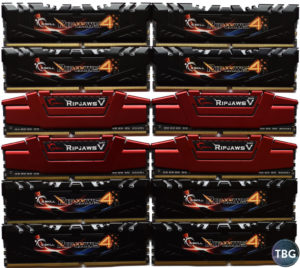
Now that DDR3 is officially being put out to pasture, it’s high time that we look at the effects of DDR4 memory on games. Of course, DDR4 is much faster that DDR3, at least in terms of frequency (timings are not quite as good, though, so all is not quite what it seems). And since we wanted to test RAM anyway, we decided to double up and cover both RAM topics in one article, so we’ll also be looking at 8GB vs. 16GB in the newest games on the market. Note that we didn’t test 4GB this time around, as DDR4 cannot be purchased in 2GB sticks, and testing a single 4GB stick in single-channel mode would make no sense at all, given how much it cuts down on bandwidth. In any event, PC builders should be looking at equipping their systems with at least 8GB of RAM due to low prices and the fact that games hitting the market this year often have minimum requirements of at least 6GB of RAM.
Test Setup
To test as many scenarios as possible, we used a total of 80GB of RAM (12 sticks in total), running them in various configurations on two test systems. The two main sets were the G.Skill Ripjaws 4 4x4GB DDR4-3000 kit and the G.Skill Ripjaws 4 4x8GB DDR4-3000 kit. We also had several sets of G.Skill’s Ripjaws V 2x8GB DDR4-2666 kits on hand to make testing go faster.
We emulated various other RAM kits by changing voltage and timings. Here are the three kits our configurations represent:
- Corsair Vengeance LPX 4x8GB DDR4-2133, 13-15-15-28, 1.2V (also available as a 2x4GB kit for $49 as of our publication date)
- Patriot Viper 4 4x8GB DDR4-2666, 15-15-15-35, 1.2V (also available as a 2x4GB kit for $48 as of our publication date)
- G.Skill TridentZ 4x8GB DDR4-3200, 16-16-16-36, 1.35V (also available as a 2x4GB kit for $75 as of our publication date)
We performed our quad-core benchmarks on the following test system:
- CPU: Intel Core i7-6700K (overclocked to 4.4GHz)
- Motherboard: Asus Z170-A (thanks to Newegg and Asus for providing this review sample)
- Video Card: EVGA GeForce GTX 980 Ti 6GB
- Solid-State Drive: Samsung 850 Evo M.2 500GB
- Power Supply: EVGA Supernova GS 850W
- Case: Phanteks Evolv
- CPU Cooler: Noctua NH-U14S (thanks to Noctua for providing this review sample)
- Operating System: Windows 10

Our hexa-core test system consisted of the following components:
- CPU: Intel Core i7-5820K (overclocked to 4.4GHz)
- Motherboard: Asus X99-Pro/USB3.1
- Video Card: EVGA GeForce GTX 980 Ti 6GB
- SSD #1: Samsung SM951 M.2 256GB
- SSD #2: 2x Samsung 850 Evo 500GB in RAID0
- Power Supply: EVGA Supernova 1000 PS
- Case: Corsair Carbide 500R
- CPU Cooler: Corsair Hydro H100i
- Operating System: Windows 10
Note that on our X99 system, our DDR4-3200 memory could not run at the same timings as it would on the Z170 system. We had to loosen the timings to 16-18-18-38, and even then it needed a bit more than 1.35V. We’re pretty confident that the X99 platform cannot run RAM faster than DDR4-3200 at this point in time, and as you’ll see, there probably isn’t a reason for motherboard manufacturers to pursue the issue (i.e., provide UEFI updates to support higher speeds).
We ran all tests at a resolution of 2560 x 1440 using maximum settings, except where specified, and our GeForce GTX 980 Ti 6GB video card was set to reference speeds, which translates to 1000/7000. Note that due to Nvidia’s GPU Boost 2.0 feature, the 980 Ti operated at 1202MHz/7000MHz at all times (we used a custom fan profile to keep it under 70 °C). The drivers utilized for the 980 Ti were GeForce 361.91 for Windows 10. We know that some readers will wonder why we didn’t test at low settings at 1080p or even 720p to draw out RAM effects. In short, this type of testing, which has been very popular over the years for everything but video card benchmarks, is based on a misunderstanding of how game engines work. The reason AMD released its Mantle API, the reason Microsoft developed DX12, and the reason the brand-new Vulkan API was just released as a follow-up to OpenGL is because game engines tax much more than the video card. Running at low settings doesn’t just lower the load on the video card, it lowers the load on the CPU and memory.
As far as resolution goes, certainly 1080p or 720p were options, but we’re confident that the market is shifting over to 1440p monitors as the new mainstream. For years 1080p has essentially been the minimum, but we believe gamers investing in new monitors will be looking to higher-resolution options, especially as prices fall. And regardless, we run our benchmarks at settings that we play at, and that we expect others to play at. Our GTX 980 Ti can run 1440p at max settings. If you have a GTX 970 or 950, or a Radeon R9 390X, 290, or 380, you’ll also max out your settings as best you can (likely maxing out 1080p), and you’ll want to know what type of memory will provide the best experience for the money. That’s what our results will show you, because most gamers run at max settings if they can, resulting in similar loads on the CPU and memory subsystems. To achieve a balanced system, it makes sense to test at settings you intend to use.
We’ll be providing results for one synthetic benchmark and seven games, as follows:
- 3DMark Fire Strike
- Crysis 3
- Battlefield 4
- Ryse: Son of Rome
- Grid Autosport
- Grand Theft Auto V
- The Witcher 3
- Rise of the Tomb Raider
By choosing a variety of both older and newer games, we hope to find out whether one or the other is more dependent on more memory or faster memory. Hopefully we’ve made clear how we performed our tests. There’s lots of data to go through, and let’s start off with an exploration of our X99 platform results, shall we?
DDR4 Speed on the Quad-Channel X99 Platform
3DMark Fire Strike
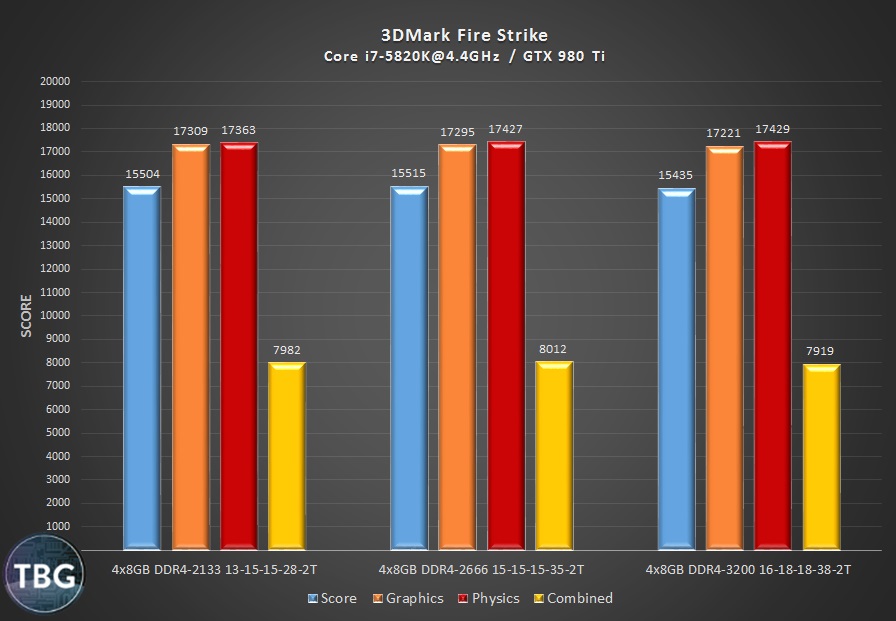
Yes, we know, 3DMark isn’t a game. But it’s a fairly popular benchmark, and it just so happens to have separate Graphics and Physics tests that focus on video card and CPU/memory performance, respectively. And that’s critical here, because we want to know whether the extra speed of DDR4 memory helps boost pure computation performance. We’ve highlighted the critical Physics Score in red here to draw your attention to it. We see a very slight (under 0.5%) boost when going from DDR4-2133 to DDR4-2666, and then the improvements end. Keep in mind that our X99 platform could not drive our 32GB (or 16GB) DDR4 kits to their maximum timings. We had to loosen them at 3200MHz, which means the increased speed may be offset by the significantly weaker timings.
Based on these results, we might expect that actual game benchmarks will run slower on DDR4-2133, but that 2666 an 3200 will be equivalent.
Crysis 3
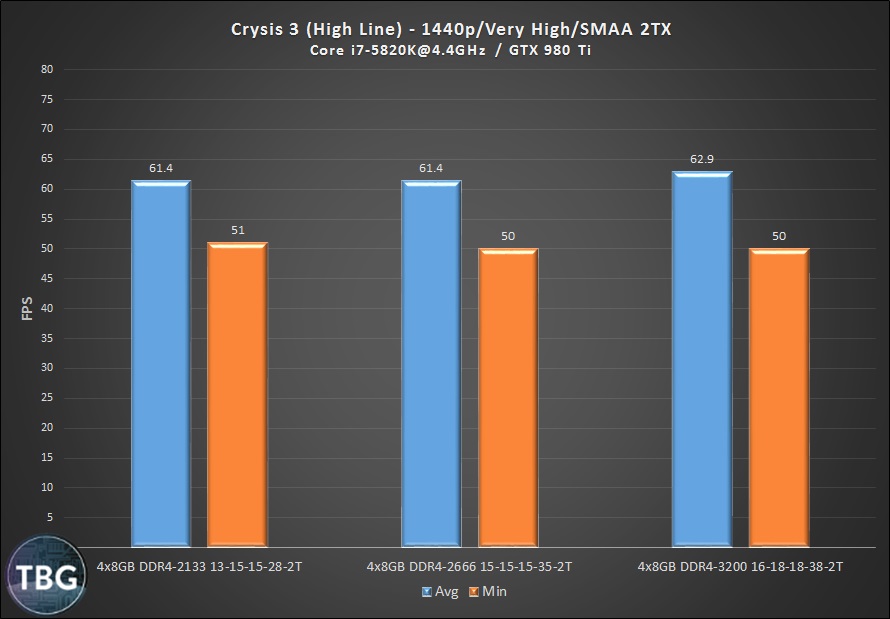
In this game, which is heavily dependent on CPU power, we see a slight boost in our 3200MHz benchmark, but otherwise performance is flat. Keep in mind that on our last page, we’ll be averaging all results, so don’t draw conclusions on the first game benchmark!
Battlefield 4
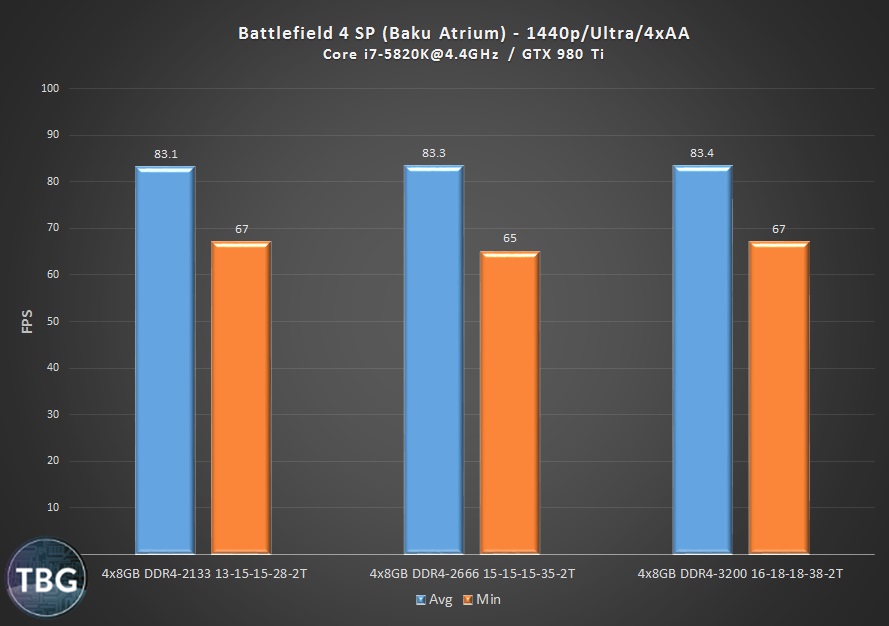
Battlefield 4 is also heavily reliant on more than video card power, even in the single-player mode we use for benchmarking. And the results show that memory speed simply doesn’t matter.
Ryse: Son of Rome
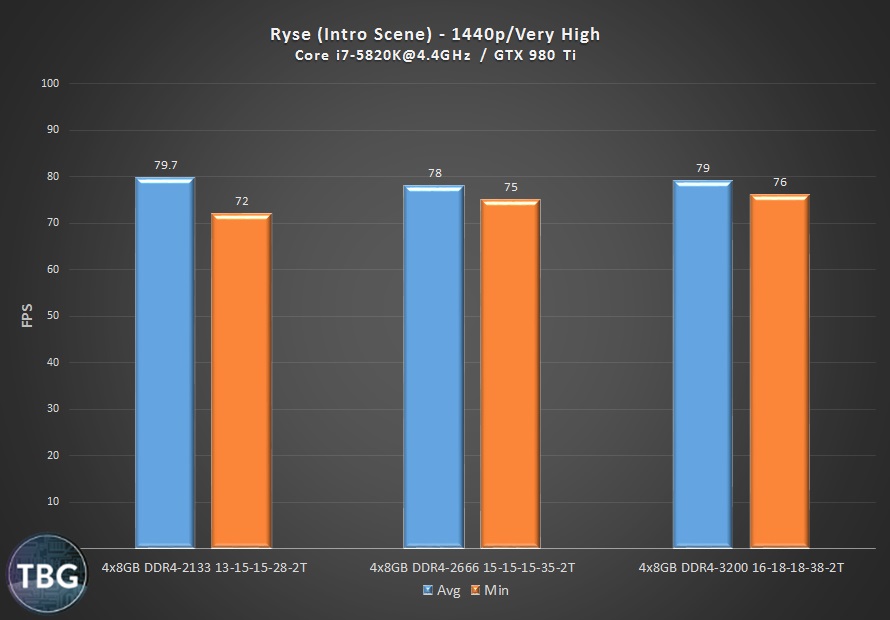
Ryse uses an updated CryEngine platform, even more advanced than what Crysis 3 uses. And as such, it will be tougher on the entire system. We run without anti-aliasing here, and yet again we see no difference in performance.
Grid Autosport
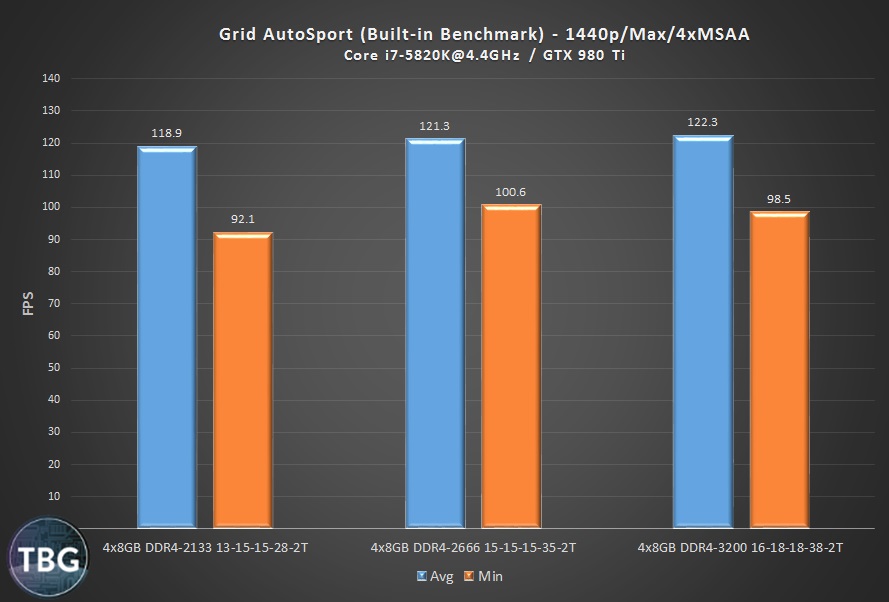
We considered benching Project: CARS here, but frankly, we think Grid still looks better. Others have waxed poetical about the beauty of CARS, but we ran both games back-to-back and the cars look a whole lot better in Grid, ironically. Anyway, this game runs so fast that it puts a big strain on the CPU and memory; it’s essentially CPU-bottlenecked. And sure enough, we see our two faster memory configurations getting a nice boost in performance, particularly with regard to the more important minimum numbers.
Grand Theft Auto V
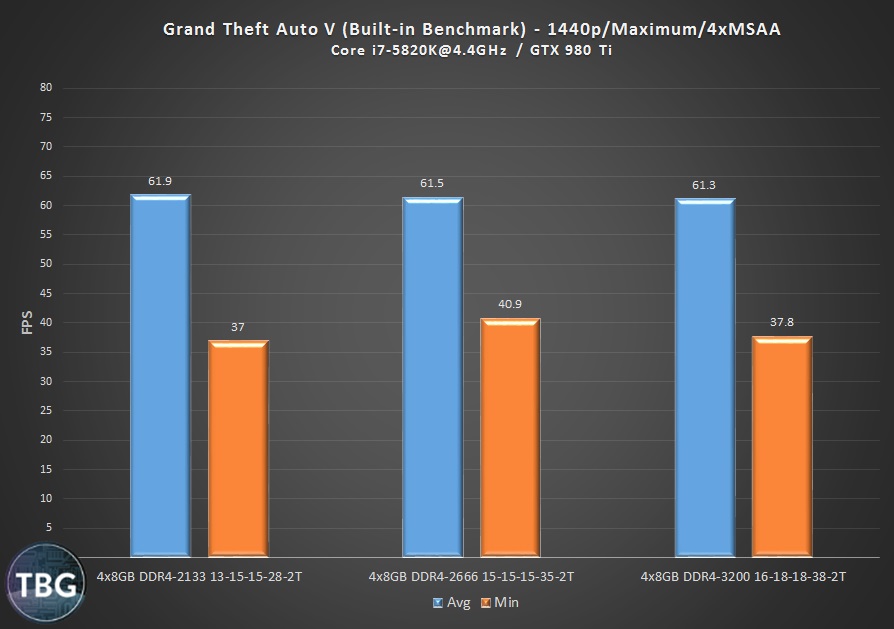
GTAV remains the best-reviewed and top-selling games of a generation, due to its classic gameplay style and huge open-world design. On the PC it’s also a serious system crusher, but here we see no significant variations based on memory speed. Note that we used the built-in benchmark, choosing Loop 3 for our representative numbers.
The Witcher 3
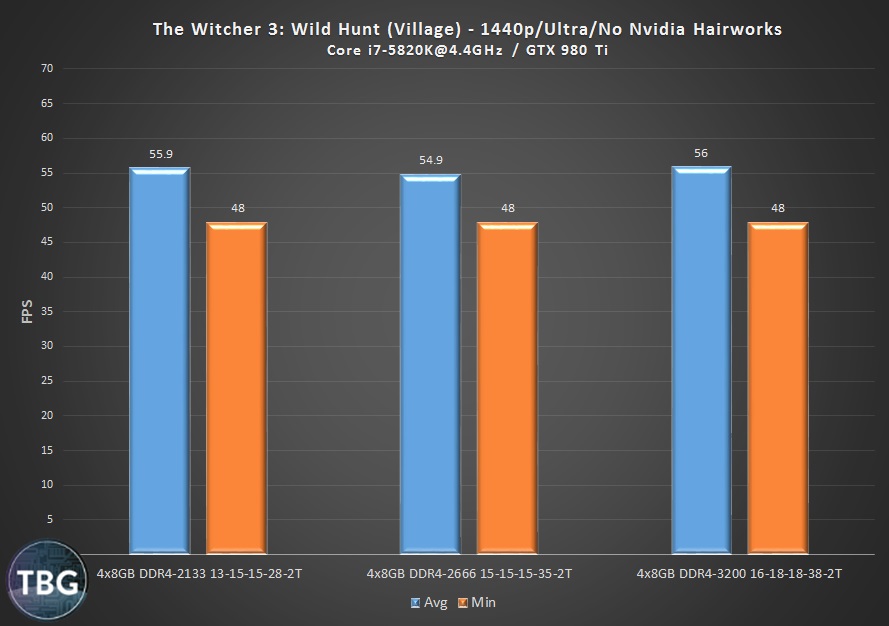
The Witcher 3 is a brute, and we actually shut off Nvidia’s Hairworks because it brings even our GTX 980 Ti to a crawl. But even without that feature turned off, memory just doesn’t come into play in this game.
Rise of the Tomb Raider
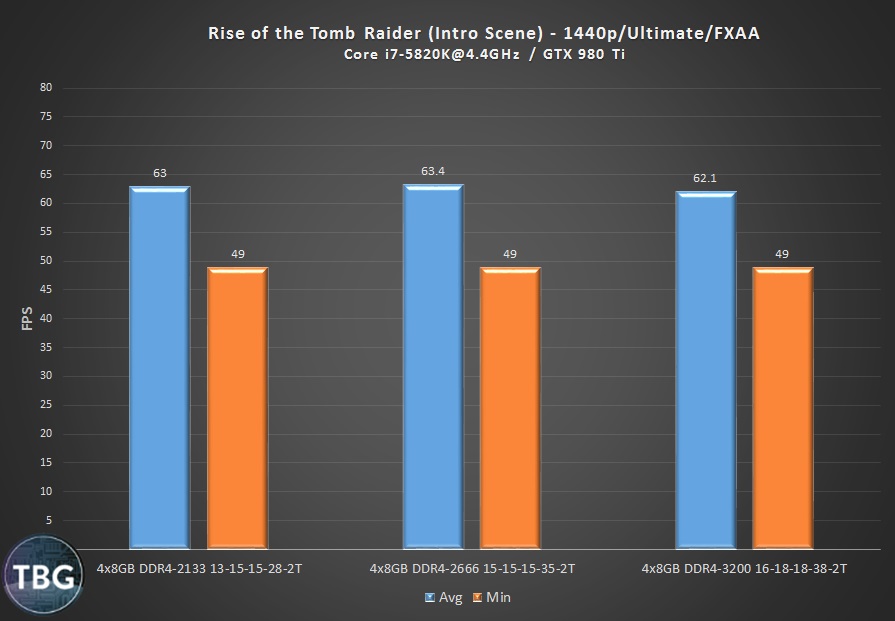
We end with the newest game in our suite, one which we’ve been looking forward to ever since 2013’s epic Tomb Raider. Bringing even bigger adventures and graphics quality never before seen on the PC, the new game Rise of the Tomb Raider is a title not to be missed. And not surprisingly, it requires nothing in the way of fast memory on the quad-channel X99 platform.
Let’s turn now to our Z170 platform, which doesn’t have the benefit of the X99’s huge inherent memory bandwidth. Perhaps faster DDR4 memory will matter more there.
DDR4 Speed on the Dual-Channel Z170 Platform
3DMark Fire Strike
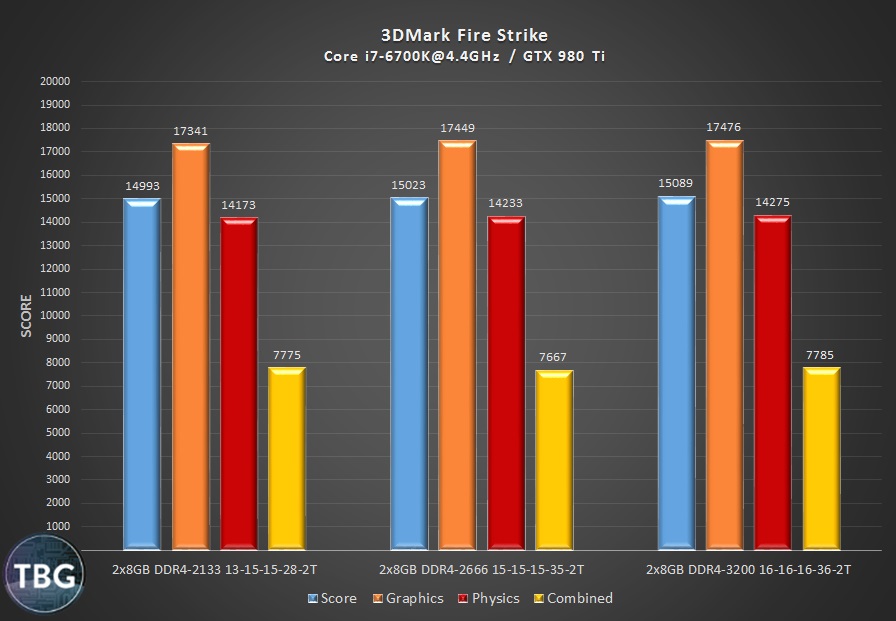
We see a 0.5% boost going to 2666MHz memory, and another 0.25% boost going to 3200MHz at tight 16-16-16-36 timings. That’s probably about as good as it’s going to get in our games!
Crysis 3
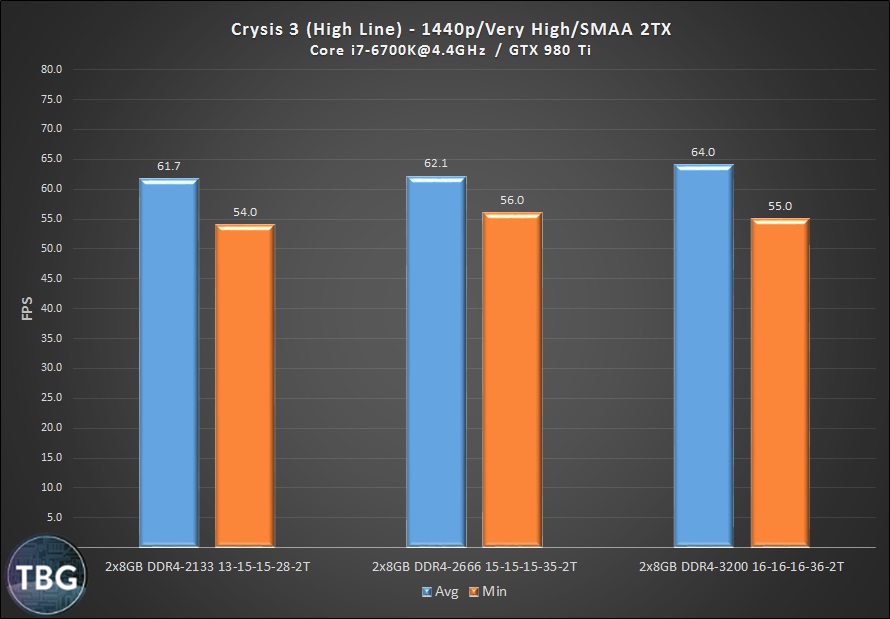
Both DDR4-2666 and DDR4-3200 perform better here, with 2666MHz claiming the minimum win and 3200MHz claiming the average win.
Battlefield 4
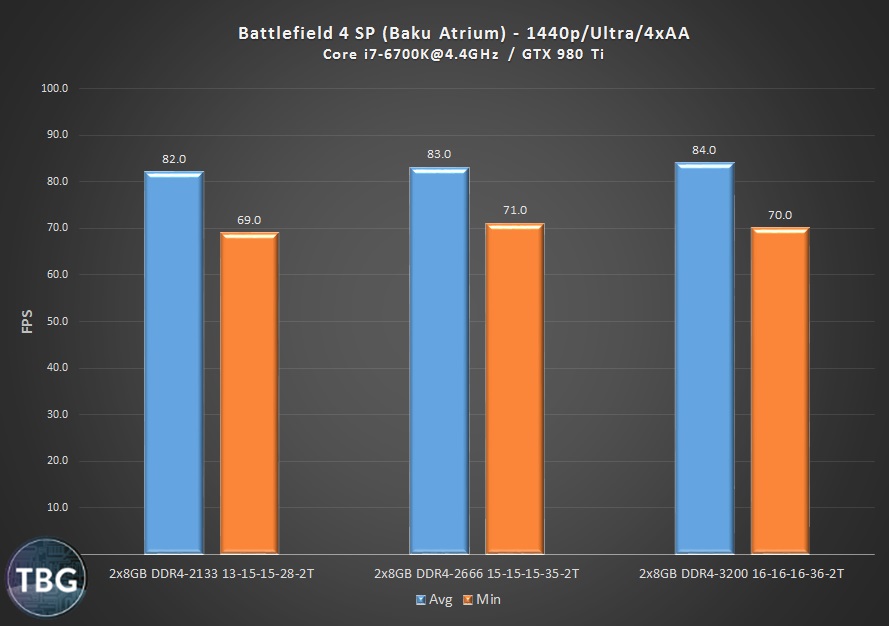
Battlefield 4 gets a slight boost from each RAM speed increase.
Ryse: Son of Rome
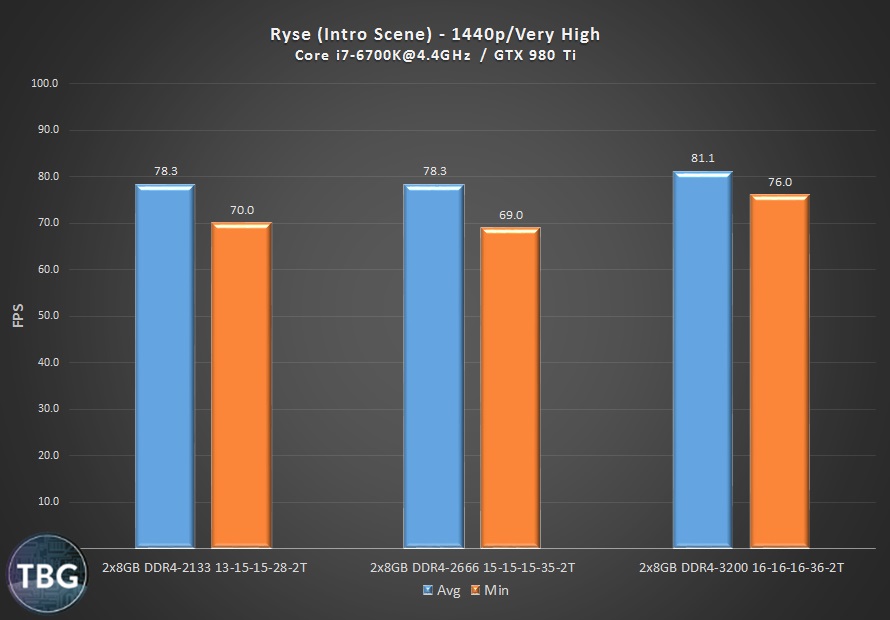
A very significant boost can be seen here. This is more than just test-to-test variation. A 4% jump in average and 8% jump in minimum performance is nothing to scoff at, and comes at little cost if running a 2x4GB kit, which as we’ll see on the next page works just fine!
Grid Autosport
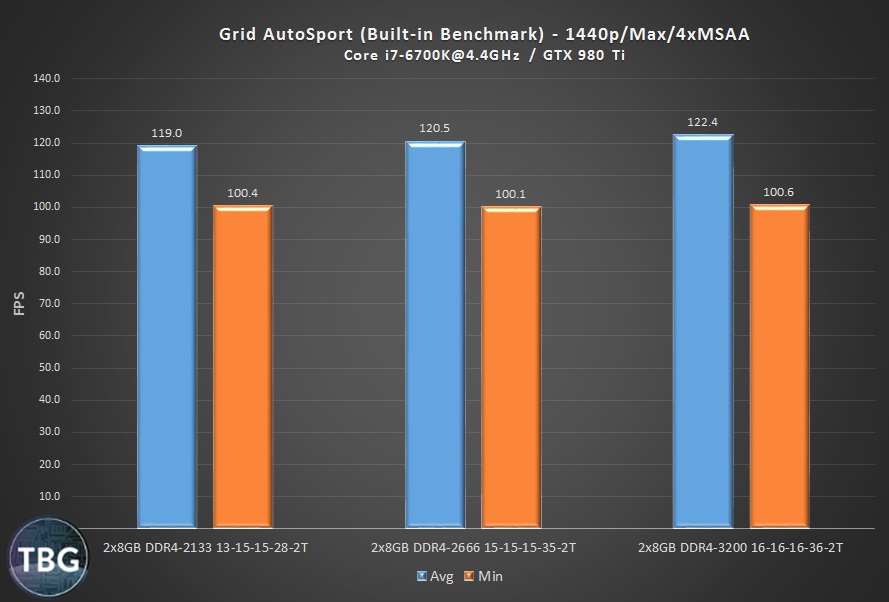
We see a slight increase in averages but not minimums here, which is unlike many of our other games.
Grand Theft Auto V
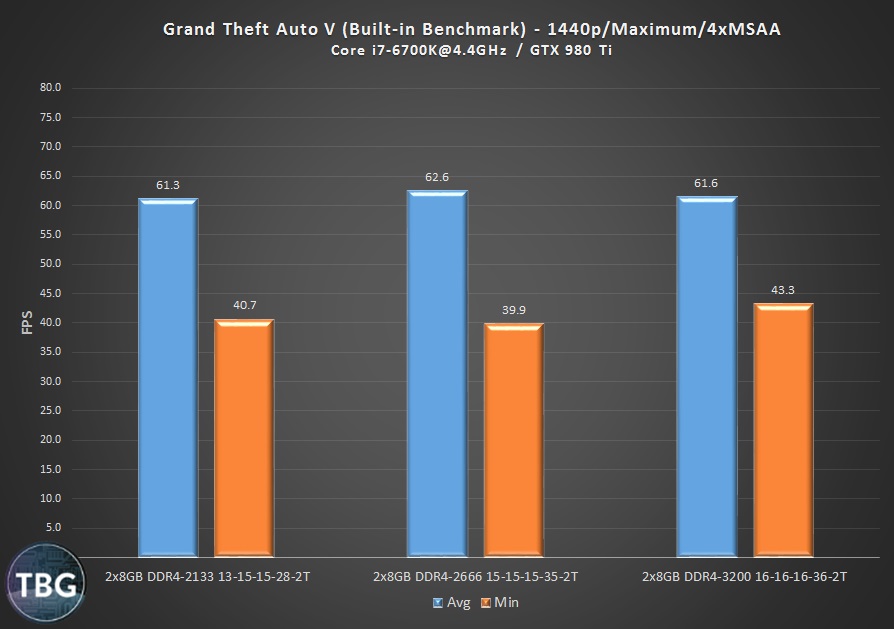
Even using the built-in benchmark led to too much variation here to draw conclusions, although faster does seem better overall.
The Witcher 3
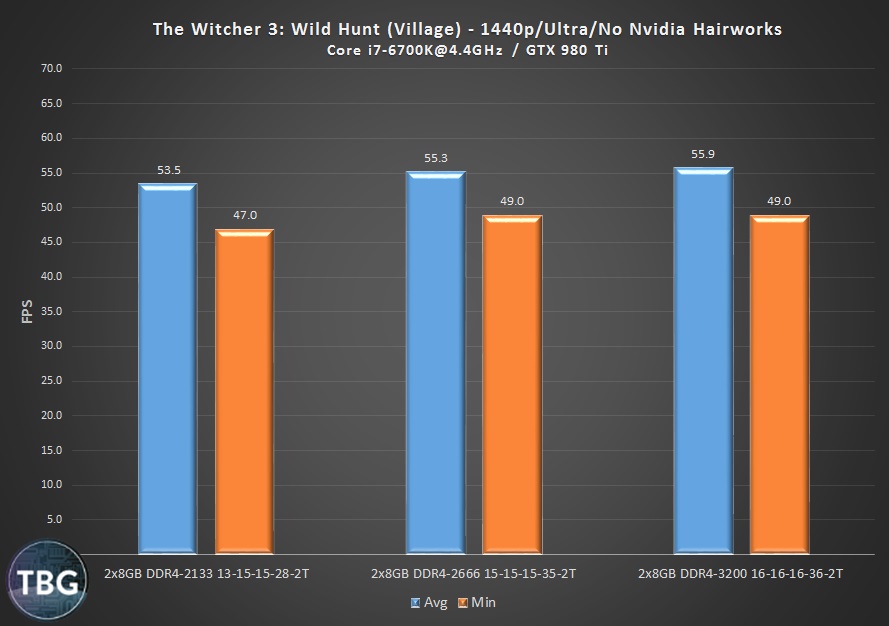
We get a big boost jumping up to DDR4-2666, but then the party ends in this, our most taxing title.
Rise of the Tomb Raider
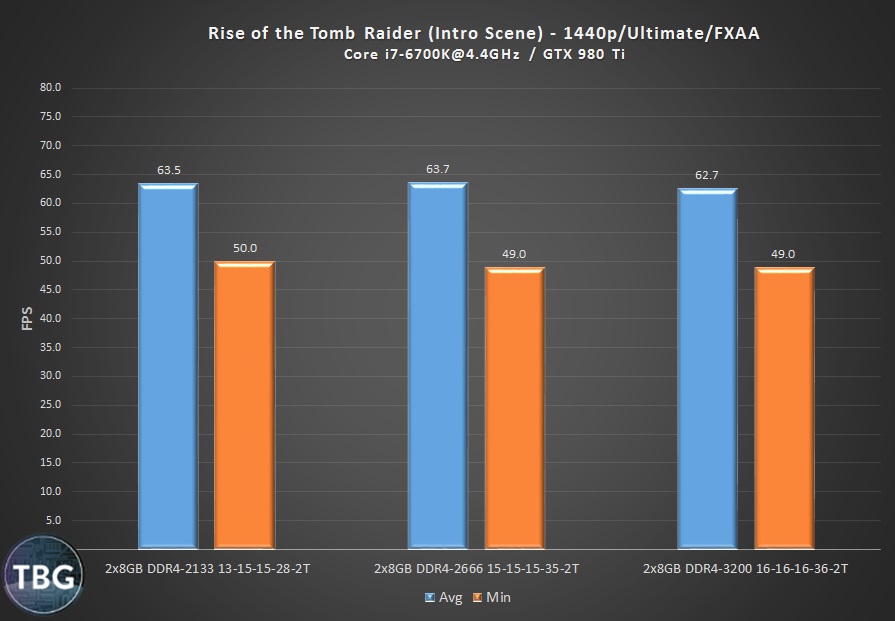
Ironic that DDR4-3200 ends up the slowest in this graphically-demanding title. You can’t win ’em all!
Now let’s turn to memory quantity to see if you take a hit dropping down to 8GB.
Gaming on 8GB vs. 16GB
Note that all of our X99 platform tests were conducted with 32GB, but we had a hunch that 32GB wasn’t actually giving the system a boost. So we repeat the results from the Z170 platform on the previous page using a 2x8GB DDR4-3200 configuration, but add in a 2x4GB configuration running at the same speed to see whether we could draw out a difference between these two dual channel configurations. Note that running a single stick is destructive to performance and should never be done on the Z170 platform, or the X99 platform for that matter.
3DMark Fire Strike

Nothing to see here, the Physics and Combined score are identical. The slight differences in the other scores result only from minor fluctuations in video card performance.
Crysis 3
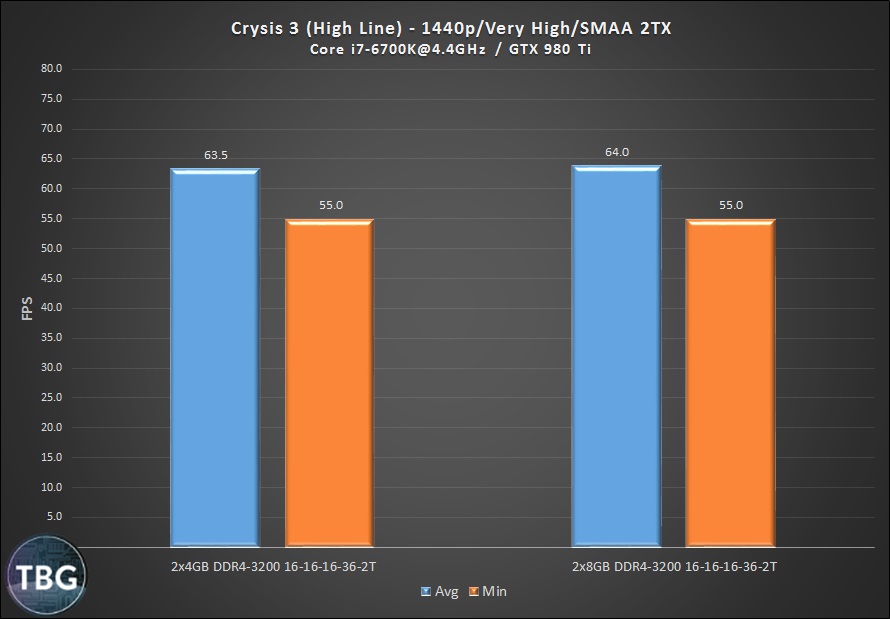
Crysis 3 doesn’t need more than 8GB of memory, and in this in-game run performs almost identically. Getting this kind of result when actually playing through a moving game world suggests there’s a very consistent engine powering the game.
Battlefield 4
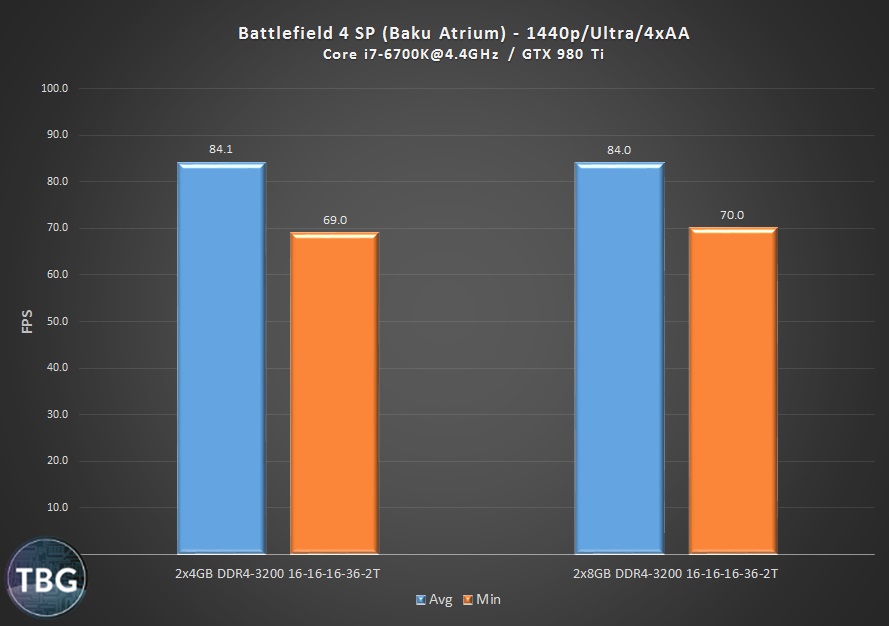
Battlefield 4’s performance is close enough to be a draw. Impressive given that this is an in-game run!
Ryse: Son of Rome
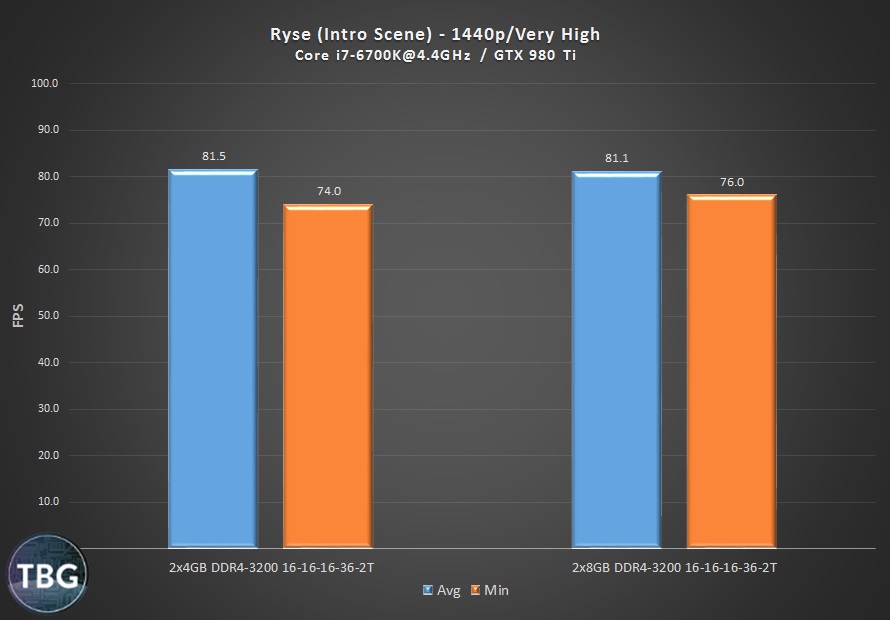
We see a very slight boost in minimums, which we’ll see in a few more games before we’re done.
Grid Autosport
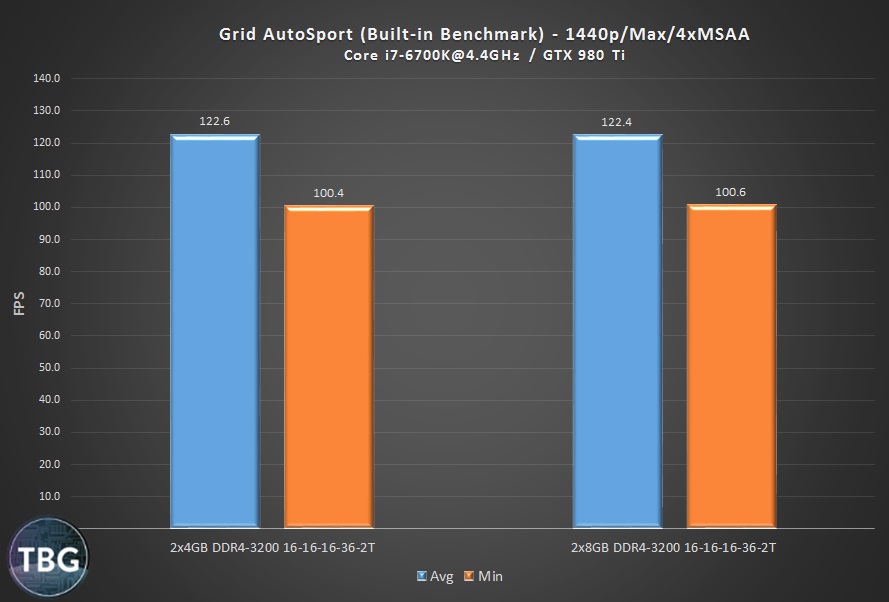
While Grid Autosport benefits from faster memory, it does not benefit from more of it.
Grand Theft Auto V
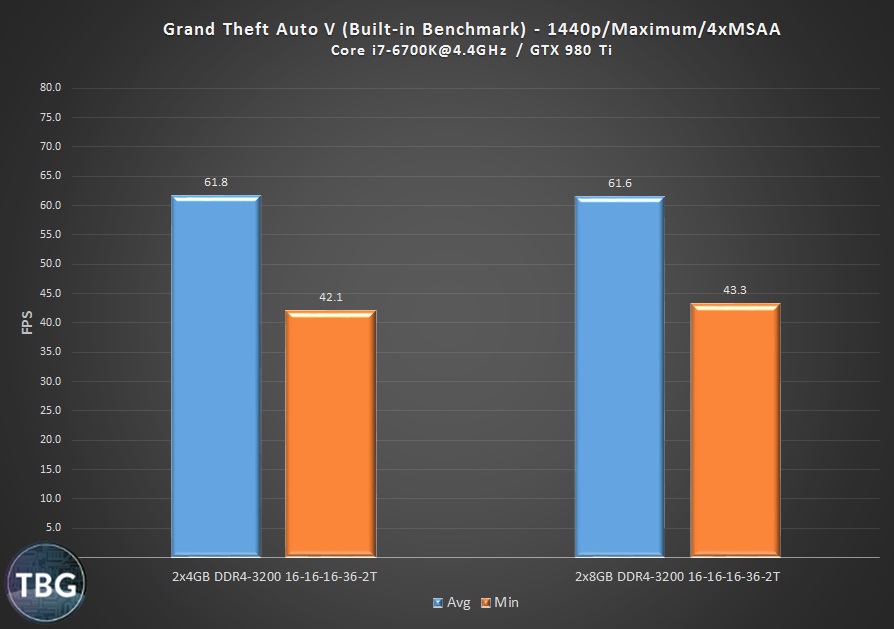
There seems to be an ever-so-slight improvement in minimums, which as we’ve said before are more important than the average, especially at these low framerates.
The Witcher 3
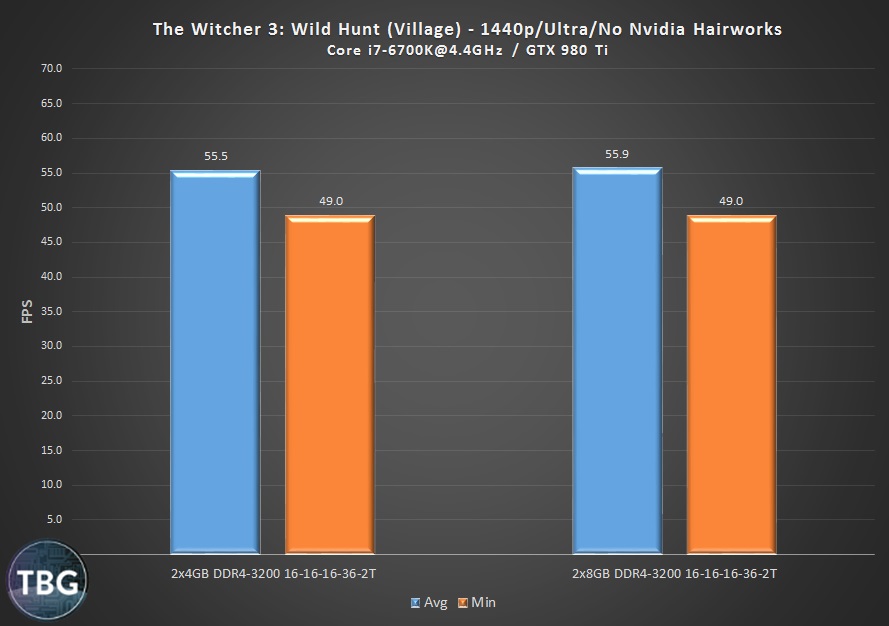
These results are a draw.
Rise of the Tomb Raider
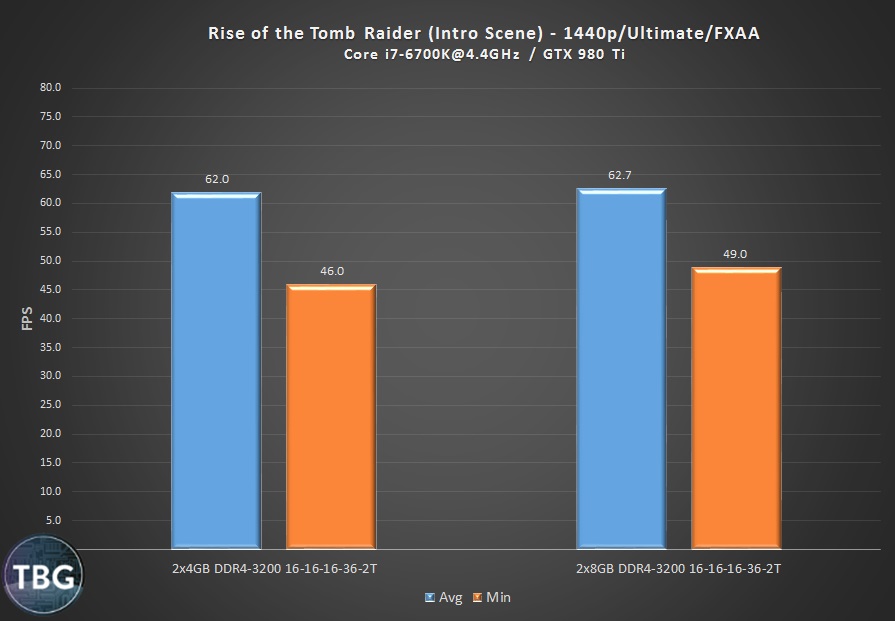
Our newest and most graphically-impressive game doesn’t get a big boost from memory quantity, although we see minimums move up a notch.
Let’s turn now to our summary results, which will allow us to draw some conclusions on the optimal DDR4 configurations for gaming on both Intel’s mainstream and enthusiast platforms.
Summary Results
Can DDR4 perform miracles, either with regard to speed or quantity? Our summary results give us the full picture.
DDR4 Speed on the Quad-Channel X99 Platform
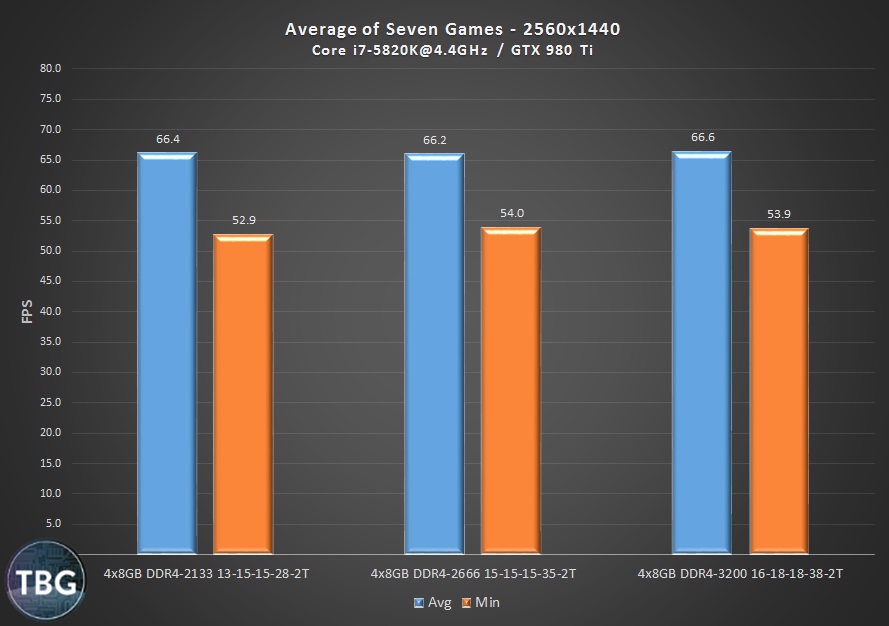
While the X99 platform does see a boost in minimums going from DDR4-2133 to DDR4-2666, that’s where the progress ends. Keep in mind that DDR4-3200 is the only speed rating above DDR4-2666 that does not require an odd 125MHz strap. That’s because 2133MHz uses an 8x multiplier, 2666MHz uses a 10x multiplier, and 3200MHz uses a 12x multiplier. But running RAM at 3200MHz taxes this platform so heavily that loose timings are necessary, and the RAM simply does not perform better than low-voltage 2666MHz sticks at tighter timings. Furthermore, we no longer recommend DDR4-2800 or DDR4-3000 for X99 systems despite their potentially lower timings because they require more voltage (1.35V) and a higher strap speed, leading to much higher power use at idle and more difficulty in CPU overclocking.
DDR4 Speed on the Dual-Channel Z170 Platform
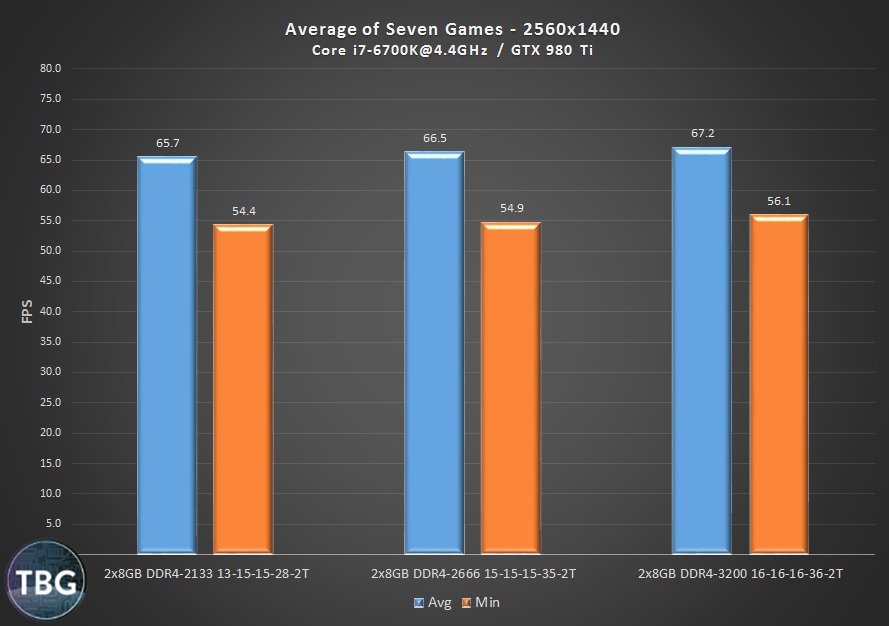
Averaged across our seven games, we see a 2% boost in average FPS and a 3% boost in minimums going from DDR4-2133 to DDR4-3200, which is relatively impressive given the settings we were playing at (maxed out at 2560×1440, typically). Investing in something other than DDR4-2133, even the fast DDR4-2133 we used, seems to be worthwhile, especially given the market-defying fact that DDR4-2666 is often cheaper! We’ve said this before and we’ll say it again: Intel made a grave error capping out its lower-end Skylake chipsets at DDR4-2133, when DDR4-2666 is faster and often cheaper, while still requiring just 1.2V. It absolutely would have been the default minimum if Skylake hadn’t been rushed to market to keep motherboard manufacturers happy (or happier than they were when Broadwell failed to appear in 2014). And unlike on the X99 platform, jumping up to DDR4-3200 does have an effect, although the extra cost of such high-speed RAM makes it a less of an obvious buy at this point.
Gaming on 8GB vs. 16GB
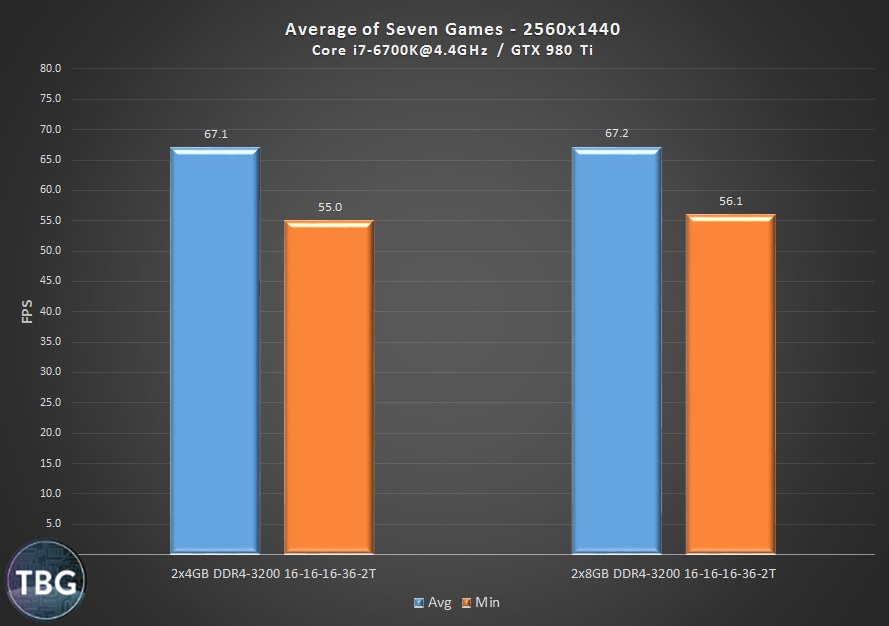
A slight boost here in minimums, although much of it can be attributed to a surprising result in Rise of the Tomb Raider. Overall we continue to find, just as we did way back in 2013, that 8GB in a dual-channel configuration is the winning bang-for-the-buck setup for gamers on Intel’s mainstream platform (with 4x4GB being the best setup on X99). More RAM allows you to do other things better, but it does not lead to a better gaming experience.
Conclusion
Overall, we’ve found that DDR4-2666 memory is definitely the optimal choice in terms of performance and value on both the X99 and Z170 platforms, and while faster memory will benefit the Z170 platform, it comes at a cost that likely isn’t worth it for gamers when the money could go to other components like CPUs and video cards. And as for memory quantity, nothing has changed over the past few years. Running with 8GB is still more than enough for any modern game, even those using the most advanced game engines. More than 8GB is great for multi-tasking and photo/video work, but gamers don’t need to feel pressured to fill all their available memory slots, even if it looks cool!
Need more advice? Well, for our take on the best overall system builds, check out our TBG Do-It-Yourself Buyer’s Guides, which are updated on a monthly basis.
